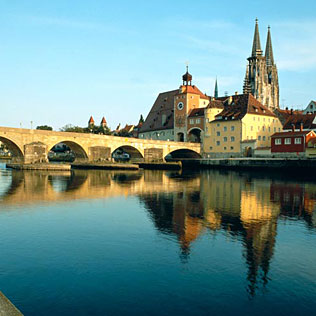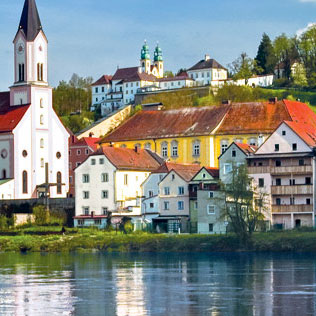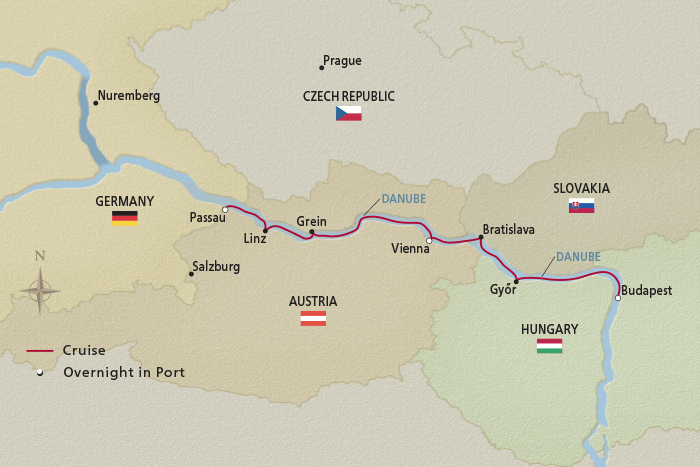Find the River Cruise you’re looking for...
10 Day Viking River Cruise from Passau to Budapest 2024

River Cruise Description
Discover quaint towns in Germany, Austria and Hungary. Celebrate Vienna and Salzburg’s musical legacy, and savor the culinary delights of Budapest and Bratislava’s brewing heritage. Enjoy scenic sailing through the Wachau Valley and admire sleepy villages along the Danube. With overnights in Vienna, Passau and Budapest, enjoy more time to fully explore. The winter season is an ideal time to visit, with fewer travelers and easier access to landmarks.Thanks for your interest!
We'll be in touch soon.Error
I'm sorry, but an error has occurred. Try Again| Departure Date | Ship | Priced From (per person) | |
|---|---|---|---|
| Dec 27, 2024 | Viking Var | Waitlist | Call Us! |
River Cruise Itinerary



Day 1 Passau, Germany
Embark your ship and settle into your stateroom. Founded by the Celts over 2,000 years ago, Passau is one of Bavaria’s oldest cities. Known as the “City of Three Rivers,” it rests at the confluence of the Inn, Ilz and Danube rivers. The city has long enjoyed its strategic position and grew to great economic and political power because of it. The legacy of its past prosperity lives on in graceful arcades, colorful houses with rococo facades and the glorious baroque St. Stephen’s Cathedral, home to one of Europe’s largest pipe organs. Passau is also where two nations meet; it is here that the German-Austrian border begins.Day 2 Passau, Germany
The pride of Passau, the massive organ in the baroque St. Stephen’s Cathedral is one of the largest outside the United States. As with most organs of its size, it grew gradually over centuries. Today, it comprises five separate organs that carry varied tonal qualities and attending a concert in its cathedral setting is truly an uplifting experience. Outside of Passau lies rural Bavaria, dotted with picturesque hamlets amongst the hills. Some of the region’s best-loved products are produced here, from its prized hams and sausages to its milk and delicious alpine cheeses.Day 3 Linz, Austria
Originally known as Lentia in its days as a 1st-century Roman castle-settlement, Linz is today’s provincial capital of Upper Austria. The city’s famous Linzer Torte, the jam-filled cake topped with almonds, hails from here and can be found in any number of cafés. In the Old Town, narrow lanes lead to the Hauptplatz, once the largest town square in Austria. Handsome patrician houses, the 17th-century Town Hall and an impressive cathedral line the open space. The steepest mountain railway in Europe delivers visitors to Pöstlingberg hill and its 18th-century pilgrimage church.Day 4 Grein, Austria
Grein is a small, well-preserved city along the Danube River, set against a backdrop of picturesque landscapes and rich history. Its old town is a collection of charming houses, narrow streets and vibrant squares. The Stadttheater Grein has a unique wooden construction, and its original 18th-century stage machinery is still used to put on performances. Perched above the town and overlooking the Danube sits the elegant Schloß Greinburg, the country’s oldest residential castle. Completed in 1493, it has been the home of the Saxe-Coburg and Gotha family since 1823.Day 5 Vienna, Austria
Known as the “City of Waltzes,” Austria’s capital city of Vienna is Europe’s center of classical music. Strauss and Mozart composed many of their finest pieces here. Vienna’s musical history is matched by the elegant, graceful architecture that lines the Ringstrasse. Baroque, neo-Renaissance, Gothic-Romanesque and other splendidly styled structures take the breath away with their grand facades. Vienna has a more intimate side too: inviting footpaths lead through spacious parks and its famed Viennese cafés sweeten any stay with coffee and the city’s delectable Sachertorte.Day 6 Vienna, Austria
In Vienna, coffee is at once an art and a long-embraced tradition that has changed the face of one of Europe’s most beloved cities. UNESCO includes the Viennese coffeehouse culture on its list of Intangible Cultural Heritages, describing the establishments as places “where time and space are consumed, but only the coffee is found on the bill.” It is considered one of life’s simple pleasures to while away an afternoon over an Einspänner coffee and a delicious pastry.Day 7 Bratislava, Slovakia
The Slovakian capital of Bratislava is filled with lovingly restored baroque city palaces and grand public squares. The Little Carpathians rise steeply in the north and the enormous hrad (or castle) perches 300 feet above the Danube, lending the city a picturesque setting. Below the castle, the Old Town boasts elegant mansions, art nouveau houses and gracious pedestrian zones. Eleven Hungarian kings and eight queens were crowned in St. Martin’s Cathedral, today a concert hall that plays a central role in the city’s rich cultural offerings.Day 8 Gyor, Hungary
Győr is known as the “City of Meetings and Rivers,” due to its location at the confluence of the Danube, Rába and Rábca rivers. While its roots go back to the 5th century BC, the city grew in importance during the 11th century, when it became an important commercial and religious center. Today, Győr is known for its architecture, which is reflected in its diverse influences and periods, such as Gothic and baroque. Győr also played a pivotal role in the history of soda water, with Ányos Jedlik credited for inventing the soda-making process during the early 19th century.Day 9 Budapest, Hungary
Scenic river views and a vibrant cultural scene blend together in Budapest to form one of Europe’s most rewarding cities. Hungary’s enchanting capital straddles the banks of the Danube, with traditional hillside Buda on one side and modern Pest on the other. By day, astounding art nouveau buildings, stalwart castles and glittering palaces set the stage for awe-inspiring strolls and long soaks in thermal spas. By night, a nostalgic glow settles in as the city’s lights dance on Danube waters, the Chain Bridge uniting it all as a dramatic centerpiece.Day 10 Budapest, Hungary
Budapest’s old town is a fascinating medieval patchwork of narrow streets and colorful houses. In the Castle District, the Matthias Church soars in gleaming Gothic glory. Adjacent, the expansive wall and seven turrets of Fisherman’s Bastion overlook the Danube, the graceful Chain Bridge and the Pest side of the river. The centerpiece of the district is the sprawling Buda Castle. Constructed in the 13th century and expanded to its current baroque splendor in the 18th century, this edifice was home to Hungary’s kings for almost 700 years. After breakfast, disembark your ship and journey home.Having trouble deciding which cruise is right for you?

